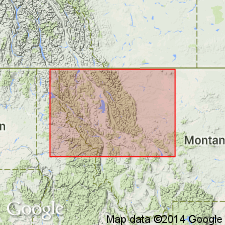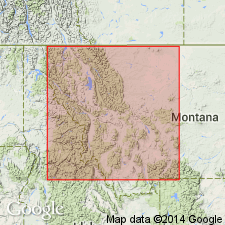
- Usage in publication:
-
- Scenic Point member
- Modifications:
-
- Named
- Dominant lithology:
-
- Argillite
- Sandstone
- AAPG geologic province:
-
- Northern Rocky Mountain region
Summary:
Named as new member at top of Appekunny formation of Ravalli group of Belt series. Type locality designated as at Scenic Point overlooking Two Medicine Valley, southeastern part of Glacier National Park, MT in the Northern Rocky Mountain region. Consists of thickly bedded quartzite and interbedded gray to rusty argillite. Type has green, purplish, buff, brown and brown-red argillite, sandstone and gravelly conglomerate 200 to 700 ft thick. Mud cracks and ripple marks common. Overlies Appistoki member of Appekunny. Underlies Rising Wolf member (reassigned from Appekunny to Grinnell as its basal member) of Grinnell formation, upper formation of Ravalli. Correlation chart. Of pre-Cambrian age.
Source: GNU records (USGS DDS-6; Denver GNULEX).

- Usage in publication:
-
- Scenic Point member
- Modifications:
-
- Not used
Summary:
Cannot be traced far enough to be valid as a formally named unit (member of Appekunny formation). Fenton and Fenton (1937) divisions of Appekunny not used in southeastern part of Glacier National Park, MT in the Northern Rocky Mountain region. Rocks described by Fenton and Fenton resemble parts of Grinnell formation.
Source: GNU records (USGS DDS-6; Denver GNULEX).
For more information, please contact Nancy Stamm, Geologic Names Committee Secretary.
Asterisk (*) indicates published by U.S. Geological Survey authors.
"No current usage" (†) implies that a name has been abandoned or has fallen into disuse. Former usage and, if known, replacement name given in parentheses ( ).
Slash (/) indicates name conflicts with nomenclatural guidelines (CSN, 1933; ACSN, 1961, 1970; NACSN, 1983, 2005, 2021). May be explained within brackets ([ ]).

